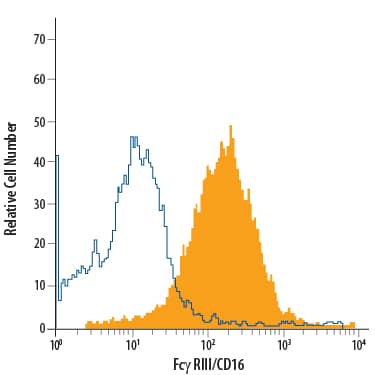Mouse Fc gamma RIII (CD16) PerCP-conjugated Antibody
R&D Systems, part of Bio-Techne | Catalog # FAB19601C


Key Product Details
Species Reactivity
Applications
Validated:
Cited:
Label
Antibody Source
Product Specifications
Immunogen
Ala31-Thr215
Accession # Q5D5J5
Specificity
Clonality
Host
Isotype
Scientific Data Images for Mouse Fc gamma RIII (CD16) PerCP-conjugated Antibody
Detection of Fc gamma RIII (CD16) in RAW 264.7 Mouse Cell Line by Flow Cytometry.
RAW 264.7 mouse monocyte/macrophage cell line was stained with Rat Anti-Mouse Fc gamma RIII (CD16) PE-conjugated Monoclonal Antibody (Catalog # FAB19601P, filled histogram) or isotype control antibody (Catalog # IC006P, open histogram). View our protocol for Staining Membrane-associated Proteins.Applications for Mouse Fc gamma RIII (CD16) PerCP-conjugated Antibody
Flow Cytometry
Sample: RAW 264.7 mouse monocyte/macrophage cell line
Formulation, Preparation, and Storage
Purification
Formulation
Shipping
Stability & Storage
- 12 months from date of receipt, 2 to 8 °C as supplied.
Background: Fc gamma RIII (CD16)
Receptors for the Fc region of IgG (Fc gamma Rs) are members of the Ig superfamily that function in the activation or inhibition of immune responses such as degranulation, phagocytosis, ADCC (antibody-dependent cellular toxicity), cytokine release, and B cell proliferation (1‑3). The Fc gamma Rs have been divided into three classes based on close relationships in their extracellular domains; these groups are designated Fc gamma RI (also known as CD64), Fc gamma RII (CD32), and Fc gamma RIII (CD16). Each group may be encoded by multiple genes and exist in different isoforms depending on species and cell type. The CD64 proteins are high affinity receptors (~10-8‑10-9 M) capable of binding monomeric IgG, whereas the CD16 and CD32 proteins bind IgG with lower affinities (~10-6‑10-7 M) only recognizing IgG aggregates surrounding multivalent antigens (1, 4). Fc gamma Rs that deliver an activating signal either have an intrinsic immunoreceptor tyrosine-based activation motif (ITAM) within their cytoplasmic domains or associate with one of the ITAM-bearing adapter subunits, Fc R gamma or zeta (3, 5). The only inhibitory member in human and mouse, Fc gamma RIIb, has an intrinsic cytoplasmic immunoreceptor tyrosine-based inhibitory motif (ITIM). The coordinated functioning of activating and inhibitory receptors is necessary for successful initiation, amplification, and termination of immune responses (5). Mouse CD16 is encoded by a single gene. The protein product is a type I transmembrane protein having two extracellular Ig-like domains. It is expressed on a variety of myeloid and lymphoid cells (4) and associates with Fc R gamma to deliver an activating signal upon ligand binding (5). Mouse CD32 is closely related to mouse CD16 throughout its extracellular domain (95% amino acid sequence identity), but has a divergent cytoplasmic domain and functions as an inhibitory receptor. Together these proteins constitute an activating/inhibiting receptor pair to regulate immune responses (5).
References
- van de Winkel, J. and P. Capes (1993) Immunol. Today 14:215.
- Raghaven, M. and P. Bjorkman (1996) Annu. Rev. Cell Dev. Biol. 12:181.
- Ravetch, J. and S. Bolland (2001) Annu. Rev. Immunol. 19:275.
- Takai, T. (2002) Nature Rev. Immunol. 2:580.
- Ravetch, J. and L. Lanier (2000) Science 290:84.
Long Name
Alternate Names
Gene Symbol
UniProt
Additional Fc gamma RIII (CD16) Products
Product Documents for Mouse Fc gamma RIII (CD16) PerCP-conjugated Antibody
Product Specific Notices for Mouse Fc gamma RIII (CD16) PerCP-conjugated Antibody
For research use only